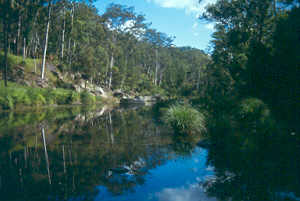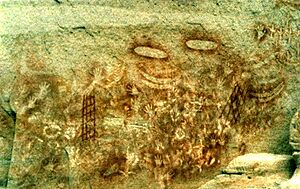Carnarvon National Park facts for kids
Quick facts for kids Carnarvon National ParkQueensland |
|
|---|---|
|
IUCN Category II (National Park)
|
|

Carnarvon Creek and Gorge
|
|
| Nearest town or city | |
| Established | 28 April 1932 |
| Area | 2,980 km2 (1,150.6 sq mi) |
| Visitation | Approx. 65,000 |
| Managing authorities | Queensland Parks and Wildlife Service |
| Website | Carnarvon National Park |
| See also | Protected areas of Queensland |
Carnarvon National Park is a special place in Central Queensland, Australia. It's about 593 kilometers (368 miles) northwest of Brisbane. This park was created in 1932 to protect the amazing Carnarvon Gorge. It's known for its beautiful scenery, important Aboriginal history, and unique rocks. The park covers a huge area of about 2,980 square kilometers (1,150 square miles).
Contents
Rocks and Landscapes of Carnarvon National Park
Carnarvon National Park sits on the Central Queensland Sandstone Belt. It also crosses the Great Dividing Range. This park shows us a lot about Queensland's long geological past. It includes two large rock basins, the Bowen and the Surat. There's also the Buckland Volcanic Province.
The newest rocks here are from volcanoes. They are called basalt rocks. These rocks formed between 35 and 27 million years ago. Since then, water and wind have slowly shaped the land. They created sandy plains, valleys, and deep gorges. These are separated by flat-topped tablelands and mountain ranges.
The park has lots of water underground. Many springs flow from these hidden water sources. High areas in the park also collect a lot of rainwater. Five big rivers start within the park's borders. These are the Comet, Dawson, Maranoa, Nogoa, and Warrego rivers.
Amazing Plants of Carnarvon National Park
Carnarvon National Park is home to 40 different types of natural areas, called regional ecosystems. Nine of these are in danger of disappearing. This is because a lot of land in the region has been cleared.
The park also protects 23 types of plants that are rare or threatened. These are protected under Queensland laws. Some famous ones include:
- The Livistona nitida, also known as the Carnarvon Fan Palm. You can find it in the Carnarvon Gorge section.
- The Cadellia pentastylis, or Ooline tree, found in the Moolayember section.
- The Stemmacantha australis, or Austral Cornflower, in the Mount Moffatt section.
Some plants here grow in separate groups far from others. Or they might be at the very edge of where they usually grow. An example is the group of Angiopteris evecta (King Fern) in Wards Canyon. This is in the Carnarvon Gorge area. The artesian springs in the Salvator Rosa section are thought to have the most different types of life in the state.
Wildlife in Carnarvon National Park
Carnarvon National Park is full of animals! Over 210 types of birds have been seen here. There are also about 60 types of mammals. The park is especially rich in bats, with at least 20 known species.
The platypus (Ornithorhyncus anatinus) lives here. This is the furthest west they are found in Queensland. Most of the park's gliding possums also live here. You can even go on night tours in Carnarvon Gorge to try and spot these amazing animals.
More than 90 types of reptiles live in the park. Over half of these are skinks or geckoes. For 35 species, this park is the edge of where they live in the state. Twenty-two types of amphibians have been found. This includes groups of the Litoria fallax (eastern Sedgefrog) and Adelotus brevis (Tusked Frog).
Over ten types of fish swim in the park's waterways. The biggest is the long-finned eel (Anguilla reinhardtii). The park also has many different kinds of insects and other small creatures. At least nine species are found only in the Carnarvon Range. These include two types of dragonflies and four types of land snails.
Sometimes, animals that are not native to the park, like wild horses (brumbies) and pigs, cause problems. They can damage the plants and land.
History of Carnarvon National Park
Carnarvon National Park has grown a lot since it first started. Carnarvon Gorge is now just one of its seven main sections. These sections include:
- Goodlife
- Salvator Rosa
- Ka Ka Mundi
- Buckland Tableland
- Mount Moffatt
- Carnarvon Gorge
- Moolayember
By adding more land, the Queensland National Parks and Wildlife Service has helped protect more water sources. They have also increased the different types of ecosystems within the park. This park is very important for protecting nature in the Southern Brigalow Belt region. Its 298,000 hectares make up over half of all protected land there.
Human History in the Park
Carnarvon National Park is very important to the Bidjara, Karingbal, and Kara Kara people. These are Aboriginal groups from Central Queensland. The park has many signs of their culture. You can see rock art sites, burial places, and old living areas.
Kenniff Cave, in the Mount Moffatt section, is a very special place. It was the first archaeological site in Australia to show that people lived on the continent much earlier than thought. Evidence from the cave, found by D.J. Mulvaney, showed people were there 19,500 years ago. Before this, people thought Australia had only been lived in for less than 10,000 years.
The Aboriginal artists who made the stencil art in Central Queensland are very skilled. Sites like the Art Gallery and Cathedral Cave in Carnarvon Gorge show their amazing work. They developed special stencilling methods not seen anywhere else. There is only one full adult body stencil known in the world. You can see it at the Tombs site in the Mount Moffatt section of the park. It is the largest known stencil. It shows how amazing this art form was in Central Queensland.
Today, Aboriginal people still have strong connections to the park's landscapes. They help protect and preserve the cultural sites.
The first European to explore this area was Thomas Mitchell in the 1840s. Settlers came after him, looking for places with permanent water. There were conflicts with the local Aboriginal groups. This continued until the 1870s.
Today, people visit the park for tourism, recreation, and conservation. The Carnarvon Gorge section is the most popular. About 65,000 people visit it each year. Mount Moffatt is the next most visited, followed by Salvator Rosa and Ka Ka Mundi. Other parts of the park are very wild because few people visit them.
Carnarvon National Park offers many fun activities. You can go four-wheel driving, watch wildlife, or hike on marked trails. You can also go bushwalking into wilder areas. There is a long trail being built that will let hikers walk around Carnarvon Gorge in about five days.
How to Get There
You can reach the Carnarvon Gorge section from either Rolleston or Injune. You travel along the Carnarvon Highway. The Mount Moffatt section can be reached from Injune or Mitchell. The Salvator Rosa and Ka Ka Mundi sections are reached by the Tambo Road. This road starts from either Tambo or Springsure.
Images for kids
See also
 In Spanish: Parque Nacional de Carnarvon para niños
In Spanish: Parque Nacional de Carnarvon para niños





